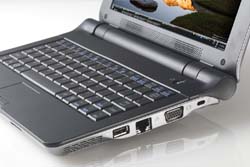Via has designs on mini-notebooks


With all the attention paid to the Intel-AMD rivalry, you may have forgotten about Via, the other company that designs x86 processors. Via hasn't kept pace with the faster, more powerful processors from Intel or AMD, relegating the company to ultra-low voltage components, largely for small form-factor PCs. But a funny thing happened. The PC industry--or at least a fast-growing segment of it--has suddenly moved toward Via.
Mini-notebooks have been gaining ground party because notebooks, in general, are growing rapidly, but mostly because lower prices have made them a viable choice for e-mail, Web browsing, and basic productivity applications on the go. Via's ultra low-voltage C7-M is well-suited for these systems, and the company got a big break when HP chose the chip for its 2133 Mini-Note. The goal of the OpenBook reference design is to lure more new customers including not only OEMs, but also carriers that may want to offer mini-notes with built-in wireless broadband.
Like most PCs in this category, the OpenBook has an 8.9-inch display, and is compact (9.4 x 6.9 x 1.4 inches) and lightweight (2.2 pounds). It is based on the Via Ultra Mobile Platform, which consists of the 1.6GHz C7-M processor and Via VX800 chipset. The latter is actually a single chip that combines the functions of the north and south bridges including the DirectX 9.0-capable Via Chrome9 HC integrated graphics. Other specs include:
- Up to 2GB DDR2 DRAM
- Choice of hard disk drives or SSDs
- WiFi, Bluetooth and optional GPS
- Choice of WiMax, HSDPA and EV-DO/W-CDMA modules
- 2-megapixel dual-headed Webcam
- Three USB 2.0 ports, a VGA port, and audio-in/audio-out jacks as well as a 4-in-1 card reader
- 4-cell 2600mA lithium-ion battery
The OpenBook is available with Windows Vista Basic, Windows XP or one of several flavors of Linux (Ubuntu, SuSe and G/OS). Via's previous reference design, the NanoBook, was the basis of several mini-notes including the Everex Cloudbook sold in the U.S., as well as systems from Packard Bell in Europe and iDOT Computers in Taiwan. This year, the category could grow to 5 to 10 million units, according to Richard Brown, Via's vice president of marketing.
Via is also reportedly very close to announcing the release of its Isaiah processor, a project that has been in the works for at least four years. The company will continue to promote the C7-M for mini-notebooks and UMPCs, while the faster Isaiah will challenge Intel and AMD processors for mainstream notebooks. Because Via does not have an IGP capable of DirectX 10 3D graphics, it is also working with Nvidia on discrete GPUs, and eventually a GeForce chipset, that will work with Isaiah.
With its ultra low-voltage products, Via is in the right place at the right time, but it faces stiff competition. It remains to be seen how the new chip will stack up to Intel's Atom, which is already finding its way into mini-notebooks and so-called Mobile Internet Devices. Ultimately "speeds and feeds" may not matter as much in this category, though. "In the end, it is going to be who gets lucky with a hardware [partner] that comes out with a great product," Brown said.